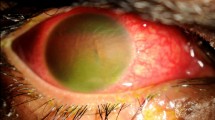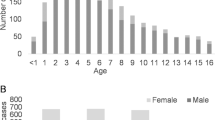Abstract
Purpose
We conducted a surveillance study to assess the nature, management, and visual outcomes of serious ocular injuries from fireworks in the UK.
Methods
New cases of serious ocular injuries from fireworks were prospectively ascertained through the monthly active surveillance system of the British Ophthalmological Surveillance Unit (BOSU). All ophthalmologists in the UK received a reporting card each month for a 2-year period commencing July 2004. They were asked to indicate any new cases of serious ocular injury from a firework, or to confirm that they had no new cases to report. Information on demographic detail, type of injury, management, and visual outcome was sought through an incident and 6-month follow-up questionnaire.
Results
Eighty-one per cent of the injuries occurred in October and November and 27% (13/47) of the patients were less than 18 years old. Twenty-six per cent (12/47) of patients had a penetrating injury, and ocular surgery was required in 53% (25/47) of cases. Eight patients (17%) required enucleation or evisceration and four (9%) required a cosmetic shell for phthisis. At 6-month follow-up, 53% (21/40) of cases had a visual acuity of 6/60 or worse.
Conclusion
This prospective national survey confirms that firework injuries are an important cause of preventable visual disability particularly to young males. It is likely that such injuries occur year on year and as such represent an important public health concern in addition to the burden placed upon the health service.
Similar content being viewed by others
Introduction
Eye injuries from fireworks can cause devastating visual and disfiguring effects. Since the late 1960s, the Department of Trade and Industry (DTI) has collected annual data on all types of injuries caused by fireworks during a 4-week period in October and November. Data collected in 2005 revealed 298 cases of ocular injuries from fireworks presenting to accident and emergency, and minor injury departments in the UK.1 These figures include all ocular injuries irrespective of severity. Furthermore, the figures give no indication of the treatment required or the visual disability incurred. As the DTI surveillance provides no indication of the cumulative visual morbidity (and by implication the cost to the public health) of ocular firework injuries, we conducted a surveillance study to assess the nature, management, and visual outcomes of serious ocular injuries from fireworks in the UK.
Materials and methods
Ethical approval was obtained from the Eastern Multi-centre Research Ethics Committee. New cases of serious ocular injuries from fireworks were prospectively ascertained through the monthly active surveillance system of the British Ophthalmological Surveillance Unit (BOSU).2 Through the BOSU all ophthalmologists with clinical autonomy in the UK are sent a reporting card each month and asked to indicate new cases of conditions of interest, or to confirm that they had no new cases to report. Serious ocular injuries from fireworks were included on the BOSU card from July 2004 to June 2006. ‘Serious’ was defined as any injury requiring admission to hospital for ophthalmic management or follow-up at an ophthalmic outpatient clinic. Therefore, reporting ophthalmologists were asked to indicate all new cases identified during the study period. Following positive notification to the BOSU, each reporting ophthalmologist was sent an incident questionnaire, which sought information on demographic detail, type of injury, and initial management. A follow-up questionnaire was also sent out at 6 months to ascertain additional management and final visual outcome. To maximise the completeness of data, non-responders were sent a reminder letter and replacement questionnaire after 4 weeks.
Results
From July 2004 to June 2006 inclusive, 76 cases of serious ocular injury from a firework were reported to the BOSU. Seven were duplicate reports, five were pre-existing cases, four were clerical errors, two were incorrectly diagnosed, and 11 reports resulted in no reply. Therefore, clinical data were made available for 47 out of a possible maximum 58 valid cases (81%). Seven patients' details were not available at the 6-month follow-up after the injury.
Seventy-four per cent of the injuries (38/47) occurred during October and November and 15 occurred on Guy Fawkes Night. Seventy-nine per cent (37/47) of the patients were male and 27% (13/47) of the patients were less than 18 years old. None of the patients was known to be wearing eye protection. Forty-five per cent (21/47) of the injuries occurred at private parties. Seventeen of the injuries (36%) were caused by a rocket, whereas in 43% (20/47) of cases the type of firework involved was unknown. The firework had been handled by the patient in 36% (17/47) of cases. In only one case was the firework known to have been thrown at the injured person. Sixty-eight per cent (32/47) of the patients had a presenting Snellen visual acuity of 6/60 or less. Posterior segment damage occurred in 68% (32/47) of patients. Twenty-six per cent (12/47) of patients had a penetrating injury, and ocular surgery was required in 53% (25/47) of cases. A total of 46 surgical procedures were performed on 25 of the patients (Table 1).
Eight patients (17%) required enucleation or evisceration and four (9%) required a cosmetic shell for phthisis. Twenty-one of the 40 patients (53%) with follow-up details at 6 months had a visual acuity of 6/60 or worse. Table 2 documents the details of the 21 patients with follow-up visual acuity of 6/60 or worse.
Fifty per cent (20/40) of patients required more than five attendances at an ophthalmic clinic within the 6 months after injury and a significant number (17/40) have remained under ophthalmic review.
Discussion
This prospective national survey confirms that firework injuries are an important cause of preventable visual disability particularly to young males causing loss of vision in a single eye for approximately 10 individuals each year. Although this number may be relatively small, the likelihood is that such injuries occur year on year and combined with the relatively young age distribution of the victims indicates that this represents an important public health concern. The reported multiple attendances of the serious cases in conjunction with the workload associated with the larger number of nonserious injuries identified through the DTI surveillance also represent a notable preventable burden upon the health service.
This is the most extensive research performed in this field in the UK to date. The stated incidence should be considered as a minimum estimate, as some questionnaires have not been returned and other cases may not have been identified; however, previous similar studies ascertaining cases through the BOSU have reported ascertainment levels of 75–100%.2 The BOSU achieved a mean monthly card return rate of 78% during the study period, which indicates a high level of compliance among reporting ophthalmologists. These factors coupled with the consistency of the number of case reports each year suggest it is likely that these data provide an accurate indication of the extent of visual morbidity caused by severe firework injuries. The study clearly reveals the visual disability, which can be incurred by fireworks and highlights the wide variety of surgical procedures involved in treating such serious injuries.
In contrast to previous papers which have reported that persons handling the firework were more likely to sustain serious eye injury than bystanders,3 in this study bystanders sustained a significant number of the eye injuries. We found that it was just as perilous to be in the vicinity of a firework being launched as to be actively involved in lighting it.
Approximately half of the injuries occurred at private parties and this was where the majority of children sustained their injuries. It is reassuring that in only one case was the firework known to have been used maliciously. This may be because of the strict legislation regarding the use of fireworks in public areas in the UK.
None of our patients were known to have worn eye protection despite evidence showing effectiveness and the value of mandatory usage in similar circumstances.4 In this study, the firework had been handled by the patient in 36% of cases and it is likely that had these patients been wearing protective polycarbonate glasses they would have avoided serious ocular injury. Public awareness on this issue needs to be raised and in particular the fact that simple spectacles do not protect against high velocity injuries. Consideration should be given to providing free protective glasses in conjunction with a firework purchase to at least protect the person handling the fireworks. Such an initiative should be government led and combined with a nationwide campaign on firework safety to increase its effectiveness.
In 1984, WHO recommended a worldwide ban on the manufacture of all fireworks.5 Strict legislation has been shown to reduce the number of firework injuries.6, 7, 8 Preventative measures have also been shown to reduce the number of injuries. American states with no firework regulations had an estimated 10-fold incidence of ocular injuries caused by fireworks compared with those states with almost a complete ban on fireworks.6 A ban on the private use of fireworks in Northern Ireland has been shown to reduce the number of ocular injuries due to fireworks.9 Although it is important to promote public awareness and education in an attempt to decrease these needless and preventable injuries, stricter legislation may be required in the UK to decrease the availability of fireworks to the public.
References
Foot B, Stanford M, Rahi J, Thompson J . The British Ophthalmological Surveillance Unit: an evaluation of the first 3 years. Eye 2002; 16: 1–7.
See L-C, Lo SK . Epidemiology of fireworks injuries: the national electronic injury surveillance system, 1980–1989. Ann Emerg Med 1994; 24: 46–50.
Pashby T . Eye injuries in Canadian amateur hockey. Can J Ophthalmol 1985; 20: 2–4.
World Health Organisation. Strategies for the Prevention of Blindness in National Programs. WHO: Geneva, 1984.
Wilson RS . Ocular firework injuries and blindness. Ophthalmology 1982; 89: 291–297.
Kuhn F, Morris R, Witherspoon CD, Mann L . Serious fireworks-related eye injuries. Ophthalmic Epidemiol 2000; 7: 139–148.
Thygesen J . Ocular injuries caused by fireworks. 25 years of experience with preventive campaigns in Denmark. Acta Ophthalmol Scand 2000; 78: 1–2.
Chan WC, Knox FA, McGinnity G, Sharkey JA . Serious eye and adnexal injuries from fireworks in Northern Ireland—an Ophthalmology unit's experience. Int Ophthalmol 2004; 25: 167–169.
Acknowledgements
We thank the Northern Ireland Optometric Society for funding and all participating ophthalmologists for their invaluable help in providing information for this study.
Author information
Authors and Affiliations
Corresponding author
Rights and permissions
About this article
Cite this article
Knox, F., Chan, W., Jackson, A. et al. A British Ophthalmological Surveillance Unit study on serious ocular injuries from fireworks in the UK. Eye 22, 944–947 (2008). https://doi.org/10.1038/sj.eye.6702778
Received:
Revised:
Accepted:
Published:
Issue Date:
DOI: https://doi.org/10.1038/sj.eye.6702778



